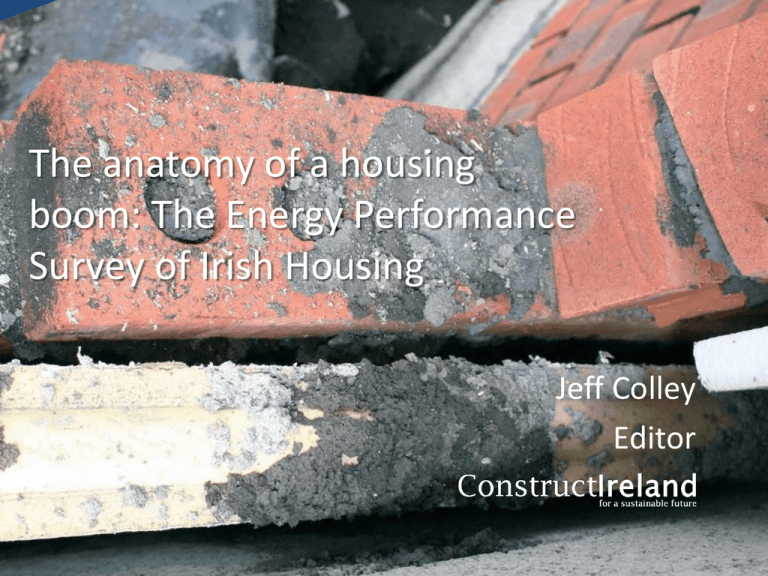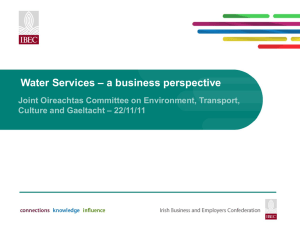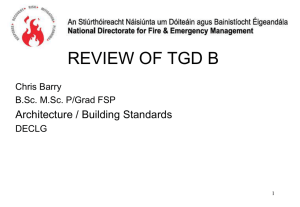Jeff Colley - Energy Action Ireland
advertisement

The anatomy of a housing boom: The Energy Performance Survey of Irish Housing Jeff Colley Editor The Energy Performance Survey of Irish Housing June 2004: SEI goes out to tender “SEI invites tenders from suitably qualified organisations or groups for the purposes of carrying out a detailed survey of Irish housing stock to determine both a) levels of compliance with existing regulations governing energy conservation and b) actual vs. theoretical energy performance. The survey will also serve as a pilot demonstration of potential Home Energy Rating methods in the context of SEI’s Home Energy Rating programme.” Tender won by Codema & DIT, working with Cork City, Galway & Tipperary Energy Agencies January-May 2005: surveying carried out May 2005: first draft submitted to SEAI The Energy Performance Survey of Irish Housing Sample was a “representative cross-section of the existing Irish national housing stock” (age of construction, house type, construction type, geographic spread & tenure of occupancy) 150 houses surveyed in total 52 post-1997 houses checked for compliance against parts F (ventilation), J (heat producing appliances) and L (conservation of fuel and energy) of building regulations, and SI 260 (boiler efficiency) The Energy Performance Survey of Irish Housing Of the 52 houses inspected: • no house complied with all 3 parts of buildings regulations; • only 1 complied in full with energy efficiency standards under TGD L, but the report claims that 85% of homes are “properly” insulated; • 52% complied with TGD J in full; • 93% of houses with oil boilers failed section 5 of TGD J – due to “an inadequate base” and “absence of any lack of a barrier”; • 29% of houses did not comply with section 1 of TGD J – CO pollution risk; • 58% met ventilation standards under TGD F. In some cases, no background ventilation was included, & in “a significant number of dwellings (estimated at 35% by one surveyor) the permanent vent is stuffed up with paper or cloth”; • 63% failed on heating controls; • 87% failed to meet air infiltration measures; • 92% failed to meet minimum insulation levels for water cylinders, pipes and ducts; • 56% of boilers met the efficiency requirements of SI 260 – 100% of condensing gas boilers, 72% of non-condensing gas boilers & 30% of non-condensing oil boilers; • significant energy efficiency losses noted due to internal dry-lining and dormer roofs The Energy Performance Survey of Irish Housing But the 85% “properly” insulated claim doesn’t stand up The Energy Performance Survey of Irish Housing The Energy Performance Survey of Irish Housing The Energy Performance Survey of Irish Housing Why does any of this matter? It’s the only report analysing compliance with building regulations (apart from a NDA report on compliance with Part M) Data from inspection of 12-15% of new homes hasn’t been collated into a compliance report Since SEAI received the 1st draft in May 2005: • Over 93,000 houses were built in 2006, the last record year • Priory Hall was completed (2006) • Over 270,000 new dwellings have been built (since start of 2006) • Over 780,000 homes built since 1997 – 39% of Ireland's entire housing stock People buying those homes (new or 2nd hand) since mid 2005 – many in negative equity & challenging accepted definitions of fuel poverty – had a right to know Would some people have thought twice before buying? The Energy Performance Survey of Irish Housing What should have happened? Publication of the report Recommendations should have been acted on for: • analysis of a larger sample (450 houses) • more detailed analysis, including thermal comfort thresholds, ventilation, alternative energy systems and domestic hot water systems The Department of the Environment should have commissioned a report on compliance with all parts (A-M) of building regulations A meaningful building control system, including rigorous site inspections and punitive actions, should have been introduced The Energy Performance Survey of Irish Housing What happened to the report? 2005/06 Elements of findings presented at 3 Sebnet meetings & the IBCI & Remic conferences, and papers given at the Solar Cities conference and submitted to the Energy Performance of Buildings Journal Feb 2007 Construct Ireland and Sunday Tribune articles in Jan/Feb 2007 based on limited data gleaned from Sebnet meetings and interview Dáil: Green TDs asked the government to publish the report Bertie Ahern: “If Deputy Sargent is saying 98% of the new houses built in this country are in breach of the existing guidelines, it is not true. […] It is another study of ten houses picked by the Deputy himself.” The Energy Performance Survey of Irish Housing Dec 2007 Dáil: current housing minister Jan O’Sullivan asked minister Gormley if his department had seen the report. His response: “My department has not received a copy of the draft or final report, although it has been given access to an extract from the executive summary of the report.” The Energy Performance Survey of Irish Housing Four years passed…. The Energy Performance Survey of Irish Housing Nov 2011 SEAI to Construct Ireland: “A number of useful studies, not necessarily for publication but often shared with stakeholders, have been commissioned to inform SEAI’s approaches to delivering on its assigned responsibilities, including advice in relation to techno-economic and policy development and implementation matters.” Department of the Environment to Construct Ireland: “The department was aware of the findings of this report through interaction with SEAI on a range of issues related to the EPBD and TGD L but as far as we are aware at this time (6 years later) the Department did not have any formal meetings or communications focussed specifically on this report.” SEAI to the Irish Examiner: “Given the nature of this particular research, it was not appropriate nor within the remit of the project to convey the findings as suggested." The Energy Performance Survey of Irish Housing “Information wants to be free” – Stuart Brand Thank you Jeff Colley Editor Ph: 01 2107513 jeff@constructireland.ie www.constructireland.ie Twitter: @constructirl To view the report visit bit.ly/seaireport








